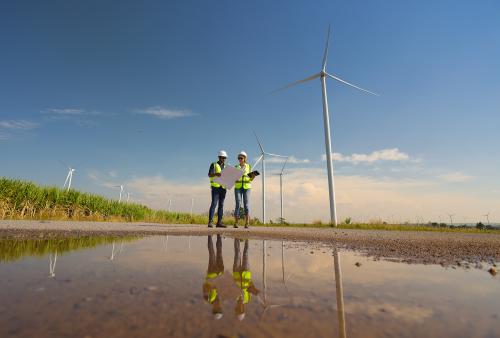At this month’s State of the Union address, President Joe Biden noted that he had inherited “an economy that was on the brink” and helped create 15 million jobs in three years. “That’s a record!” he shouted. And it’s a record that’s especially promising for workers who construct, operate, and maintain our infrastructure—a sector boosted by historic federal investment over the past couple years and with the potential to support economic growth for years to come.
But despite all this talk, the reality is that too many workers—including those in infrastructure—are struggling to stay afloat and grow their careers. Many battle fatigue and leave their jobs, or earn low pay and experience persistent poverty—two barriers worsened by troubling labor force participation rates that suggest a tough road ahead for the economy.
We not only need to quell this threat, but also support more workers—and more lasting economic opportunity. That requires a systemic accounting of these challenges, particularly in the infrastructure sector. And ideally, federal, state, and local leaders can coordinate on systemic solutions that last well beyond the next election.
There is undoubtedly huge potential from the historic federal funding via the Infrastructure Investment and Jobs Act, Inflation Reduction Act, and CHIPS and Science Act. According to research commissioned by the National Skills Coalition and BlueGreen Alliance, these laws will generate nearly 3 million jobs on average per year and 19 million jobs in total—an awe-inspiring forecast. This research also shows that 69% of these jobs will be available to workers without a bachelor’s degree, compared to 59% across all jobs in the U.S.
But maximizing the reach of this funding will necessitate significant investment in training and skills development for workers across a variety of occupations. That’s especially the case for investment in short-term training programs and on-the-job training programs, which have often lacked such support.
Such training programs will be vital for construction and manufacturing occupations, which represent two out of every three jobs these federal investments will directly create. Thousands of construction laborers, powerline installers, plumbers, electricians, and others will need quality non-degree credentials, related skills training, apprenticeships, and other workforce programs. If they are to rebuild our physical landscape, we must rebuild the pathways to those good careers across the infrastructure sector.
Targeted outreach and training will be key too. Women and people of color—who together make up most of the U.S. workforce—are still underrepresented in occupations that stand to benefit from these investments. They have faced a long history of discrimination in education and employment, which has relegated them to low-wage, highly exploited occupations and shut them out of a middle-class life and financial freedom. Investments in community-based organizations, industry partnerships, and local hiring initiatives can support recruitment, retention, and career advancement for women and people of color across the infrastructure sector.
We must also respond to worsening retention challenges in the infrastructure sector. Brookings research shows that nearly 17 million infrastructure workers will permanently leave their jobs over the next decade due to retirements, job transfers, and other labor market shifts. Despite the lower formal educational barriers, wage premiums, and urgent hiring and training needs among many employers in this sector, these retention challenges persist.
So, what are some of the systemic solutions to these challenges?
Durable funding for inclusive education and training programs is a must, including pre-apprenticeships, registered apprenticeships, and postsecondary education programs that support skills development. Recognition of the barriers women and workers of color face to get to a job or training is also key; funding for transportation support, affordable child care, and long-term care can help.
Strengthening union membership can also promote quality jobs with worker protections and other benefits such as health insurance coverage. And continuing to better define, measure, and address infrastructure workforce needs over time—skills, hiring and training barriers, and more—can help policymakers assess workforce gaps and target support across states, regions, and occupations.
The State of the Union address has swung open a critical dialogue on infrastructure and the workforce. Now, let’s deepen it to truly support workers.





Commentary
Building a stronger infrastructure workforce requires more than money
March 20, 2024